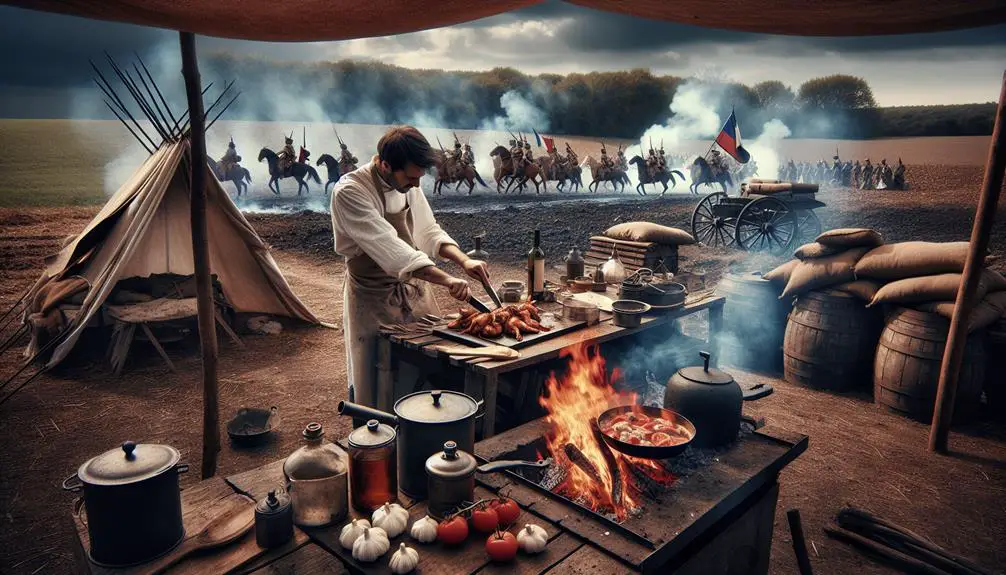Chicken Marengo is a special chicken dish that has an interesting story behind it. It all started a long time ago during a big battle.
Napoleon, a famous leader, won the battle of Marengo and his chef had to make a victory meal with only a few things he could find around. That’s how Chicken Marengo was made for the first time.
This dish has changed a lot since then. People have added new ingredients and made it in different ways, but it’s still very popular. It’s liked by many because it has a cool story and it tastes good.
To make Chicken Marengo, you usually need chicken, tomatoes, onions, and some herbs. There are many recipes out there, so you can choose what you like to add, like mushrooms or olives. It’s kind of like making a pizza; you can put on it what you think will taste good.
Chicken Marengo shows us that sometimes, great things can come from tough situations, and it also teaches us a bit about history and how people used to cook.
The Historical Backdrop

On June 14, 1800, Napoleon Bonaparte won an important battle at Marengo. This victory led to the creation of a famous dish named after the battle.
The story goes that after the battle, Napoleon’s chef, Dunand, had to find ingredients to make a victory meal. He used chicken, crayfish, and other local items.
The dish he made was liked a lot by Napoleon, who wanted it after every win. But, this story mightn’t be completely true.
The dish we call Chicken Marengo now has tomatoes, which Dunand wouldn’t have used back then because people in Europe didn’t eat tomatoes much at that time.
It’s more likely that a restaurant chef made Chicken Marengo to celebrate Napoleon’s win. Over time, this dish became popular.
Even though we’re not sure how it really started, Chicken Marengo is famous in cooking history. It shows how creativity comes from needing to solve problems.
Today, people all over the world enjoy different versions of Chicken Marengo, reminding us of Napoleon’s victory at Marengo.
The Birth of Chicken Marengo

After winning the Battle of Marengo, Napoleon’s chef had to prepare a victory meal with very few ingredients available.
Chef Dunand had to find local ingredients because their food supplies were not yet available. He had to quickly put together a dish to celebrate Napoleon’s victory.
The first version of the dish was made with whatever ingredients were available, such as chicken, crayfish, and some herbs.
Interestingly, tomatoes, which are commonly used now, were not included in the original recipe, making the dish’s history quite intriguing.
The name of the dish, Chicken Marengo, was chosen to commemorate Napoleon’s victory at Marengo.
It’s interesting to see how a dish created out of necessity has lasted for so many years, changing over time but always remembering its original story.
| Ingredient | Original Use | Modern Adaptation |
|---|---|---|
| Chicken | Main protein | Still central |
| Crayfish | Luxury addition | Often left out |
| Tomatoes | Not included at first | Now a key part |
This table shows how Chicken Marengo has evolved from a simple, improvised dish to a well-loved recipe today.
Even though there are myths about how it was first made, the dish is a great example of creative cooking under pressure. Whether tomatoes were in the original recipe or not, the resulting dish is a tasty celebration of victory and perseverance.
The Evolution of Chicken Marengo

Exploring the origins of Chicken Marengo shows it started simply, but over time, it has changed a lot, showing how chefs around the world have been creative with it.
Many different versions of Chicken Marengo exist, each reflecting local tastes and what ingredients are available.
Originally made with whatever was available after a battle, now, the dish uses common kitchen ingredients, making it easy for anyone to make.
Looking into its history, the first Chicken Marengo mightn’t have had tomatoes. Over time, chefs have tried adding or removing ingredients like crayfish and mushrooms to make the recipe fit modern tastes and what ingredients are available.
It’s interesting to see how a dish that began in such a specific and simple way can change so much from one kitchen to another.
Today, Chicken Marengo can be quite different. Some chefs keep the basic idea—chicken with a rich, savory sauce—but add things like olives, capers, or different wines to make it taste better. These changes honor the dish’s long history and show how creative cooking can be.
Chicken Marengo has also changed as it has moved across cultures, with each culture adding its own touch.
For example, Asian versions might add spices, while European versions might include local herbs. Chicken Marengo has become a way for people to express themselves through cooking.
Exploring these versions shows how a dish can keep inspiring and changing, proving that food is a way for people all over the world to connect.
The Culinary Legacy of Chicken Marengo

Chicken Marengo started as a simple dish during a battle but has become an important part of French cooking, attracting chefs and food lovers all over the world. This dish shows how food can evolve and become a symbol of creativity and survival.
Many respected French restaurants and bistros have Chicken Marengo on their menus. Chefs honor its history but also add new touches to it. It’s more than just food; it tells a story that keeps people interested.
Chefs in places from Paris to New York have put their own spin on Chicken Marengo, helping its story continue in the world of cooking.
People love Chicken Marengo not just for its taste but also for its historical significance. Food enthusiasts and historians are keen to learn about its origins and how it became so famous.
This interest in Chicken Marengo and other historical dishes shows how much people want to connect with history through food.
Eating Chicken Marengo is like participating in a long-standing tradition. It shows how food can share stories, stir feelings, and bring people together.
How to Make Your Own Chicken Marengo

If you’re eager to bring a taste of history to your table, crafting your own Chicken Marengo is a rewarding journey into culinary heritage. It’s all about balancing authenticity with modern tweaks that cater to contemporary palates. Here’s how you can pay homage to this classic dish while making it uniquely yours.
- Savor the rich history with each bite, knowing you’re partaking in a meal that’s been relished through centuries.
- Feel the thrill of connecting with famous figures of the past, imagining Napoleon himself enjoying this very dish.
- Experience the joy of creating something both timeless and personal, a dish that tells a story.
- Revel in the pride of mastering a recipe that blends tradition with your own culinary creativity.
Tips for authenticity while making adaptations for contemporary tastes
To make an authentic yet modern Chicken Marengo, pick high-quality chicken and fresh ingredients. Use organic chicken for better taste and texture.
Fresh tomatoes, herbs, and quality olive oil will make the dish more authentic. Adding tomatoes gives a modern touch, as the original recipe mightn’t have included them.
Use shrimp as a modern and easier option instead of crayfish. Serve with garlic mashed potatoes or a green salad to match the dish’s rich flavors.
Wrapping Up
Chicken Marengo has a cool history. It started on a battlefield and now people all over the world cook it.
We’ve talked about where it comes from, how it’s changed, and even how to make it.
Whether you like the story of Chicken Marengo or just think it tastes good, it’s a special dish.
Why not try making Chicken Marengo at home tonight and be part of its long story?
